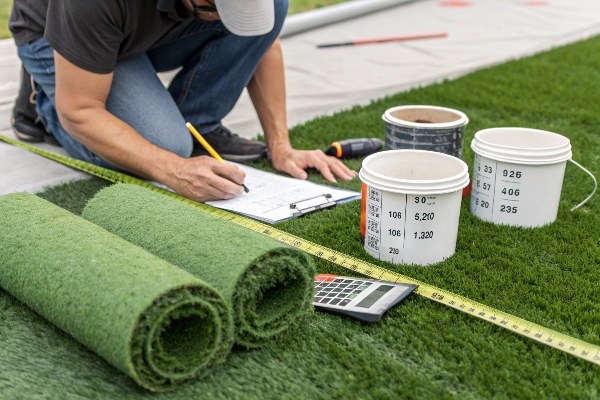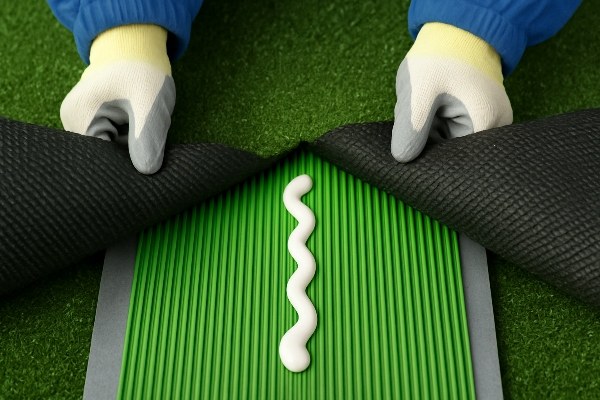Stuck on how much turf adhesive to buy for your project? Buying too much wastes money, while too little means project delays. Here’s a simple guide to get it right.
As a general rule, one 310ml cartridge of adhesive covers about 3-4 linear meters of a seam. A larger 5kg tub will cover approximately 15-20 linear meters. Always check the manufacturer’s instructions, as coverage varies by product, trowel size, and how thickly you apply it.

Getting the quantity right is the first step. But knowing how much to buy won’t help if you don’t use it correctly. The application process is just as important for creating strong, invisible seams that last for years. Let’s explore the proper techniques for applying adhesive, joining turf panels, and other essential installation details that guarantee a professional finish. Getting these details right is what separates an average job from a great one.
How to apply artificial grass adhesive?
Applying adhesive seems easy, but one wrong move can create lumps and weak seams. I will guide you through the professional method for a perfect, invisible join every time.
Apply adhesive in a zigzag pattern directly onto the center of your joining tape. Then, use a notched trowel to spread it evenly across the tape’s surface. This method ensures full coverage without using too much glue, creating a strong and durable bond for your artificial grass seams.

In my years as an engineer, I’ve seen more seam failures from poor application than from bad adhesive. Spreading the glue correctly is critical. First, make sure your seam tape is laid down correctly under the join, with the shiny, non-porous side facing down. The glue goes on the rough, fabric-like side. When you apply the glue, don’t just put a single bead down the middle. A zigzag pattern gives you better initial distribution.
Then, you must spread it. I recommend a trowel with 3mm or 4mm notches.
Key Application Steps
| Step | Action | Why It’s Important |
|---|---|---|
| 1. Preparation | Unroll seam tape under the join, fabric side up. | Provides the surface for the adhesive to bond with the turf backing. |
| 2. Application | Apply adhesive in a zigzag pattern along the tape. | Ensures glue is distributed across the width of the tape. |
| 3. Spreading | Use a notched trowel to spread the glue evenly. | Creates ridges that provide a better grip and a consistent glue thickness. |
| 4. Pressing | Carefully press the turf edges into the wet adhesive. | Ensures full contact between the turf backing and the glue. |
Using a notched trowel is a trick the pros use. It creates small ridges in the glue. When you press the turf down, these ridges collapse and spread, forcing the adhesive into every part of the turf backing. This creates a much stronger bond than a flat layer of glue.
How to join two pieces of artificial grass?
A visible seam can ruin the look of a perfect lawn. Are you worried your installation will look like a patchwork quilt? I’ll show you how to make your seams disappear.
Lay the two turf pieces side-by-side, ensuring the grain faces the same direction. Leave a tiny gap of 1-2mm between them. Fold back the edges, place joining tape underneath (fabric side up), apply adhesive, and firmly press the turf edges together onto the tape.

Creating an invisible seam is an art form, but it’s one you can master with patience. The most important rule is to check that the pile direction, or grain, of both pieces is pointing the same way. If they are not, the color and texture will look completely different, and no amount of skill can hide that.
Before you even think about glue, do a "dry lay1". Place the two pieces together and make sure they fit perfectly. I always recommend trimming 2-3 stitch rows from the factory edge of each piece. You do this from the back with a sharp utility knife. This gives you a clean, fresh edge to join, which is much better than the often-compressed edge from the factory roll.
The Seaming Process
- Align the Grain: Make sure the grass blades on both pieces point in the same direction. This is the most crucial step for an invisible seam.
- Trim the Edges: From the back, carefully cut off 2-3 rows of stitches from the edges you plan to join. This creates a clean, straight edge.
- Position the Turf: Lay the pieces down with a very small gap between them, about the width of a coin (1-2mm). This gap allows the turf backing to expand without overlapping.
- Join with Tape and Glue: Fold back the edges, position your seam tape, apply your adhesive as we discussed, and carefully press both grass edges back down onto the tape. Walk along the seam to ensure good contact.
I once worked on a project where the team forgot to check the grain direction. The seam looked like a dark line running across an otherwise perfect field. We had to cut out the entire panel and replace it, a costly mistake that could have been avoided by following that one simple rule.
How many nails do I need for artificial turf?
You’ve seamed your turf perfectly, but now it’s lifting at the edges. Are you using enough nails to secure it? I’ll give you clear guidelines for a secure perimeter.
To secure the perimeter, use 6-inch (150mm) galvanized nails. Place one nail every 15-20 cm (6-8 inches) around the entire edge. Be sure to hammer them in carefully so they sit just below the backing and are hidden by the grass fibers.

Nailing the perimeter is the final step that locks your entire installation in place. It prevents the edges from curling up, stops wind from getting underneath, and creates a clean, finished look. The type of nail you use is very important. Always use galvanized steel nails. I’ve seen installations where people used standard nails to save a little money. After a few months, rust stains started bleeding through the turf, ruining the appearance. Galvanized nails are coated in zinc to prevent rust, so they are essential for a long-lasting, clean installation.
Nailing Technique and Placement
The goal is to secure the turf in a way that is both strong and invisible.
- Nail Spacing: A nail every 15-20 cm provides excellent holding power. In high-traffic areas or on slopes, you might reduce this to every 10-15 cm for extra security.
- Hiding the Nail: Don’t just hammer the nail through the grass blades. This will trap the fibers and create ugly dimples. Instead, use your fingers to separate the grass fibers so you can see the black backing underneath. Hammer the nail directly through the backing.
- Nail Depth: Drive the nail until the head is just below the level of the backing. You don’t want it sticking up, but you also don’t want to hammer it so far that it creates a large dip in the turf. After the nail is in, simply fluff the grass fibers over the top to hide it completely.
Following this method ensures your turf stays put, with no visible signs of how it’s being held down. It’s the finishing touch on a professional job.
Conclusion
Calculating adhesive, joining seams, and nailing edges are key to a professional turf installation. Follow these simple steps and expert tips to ensure a durable and flawless result for your project.
-
Explore the dry lay technique to ensure perfect fit before gluing your turf. ↩
_画板-1.png)
_画板-1.png)